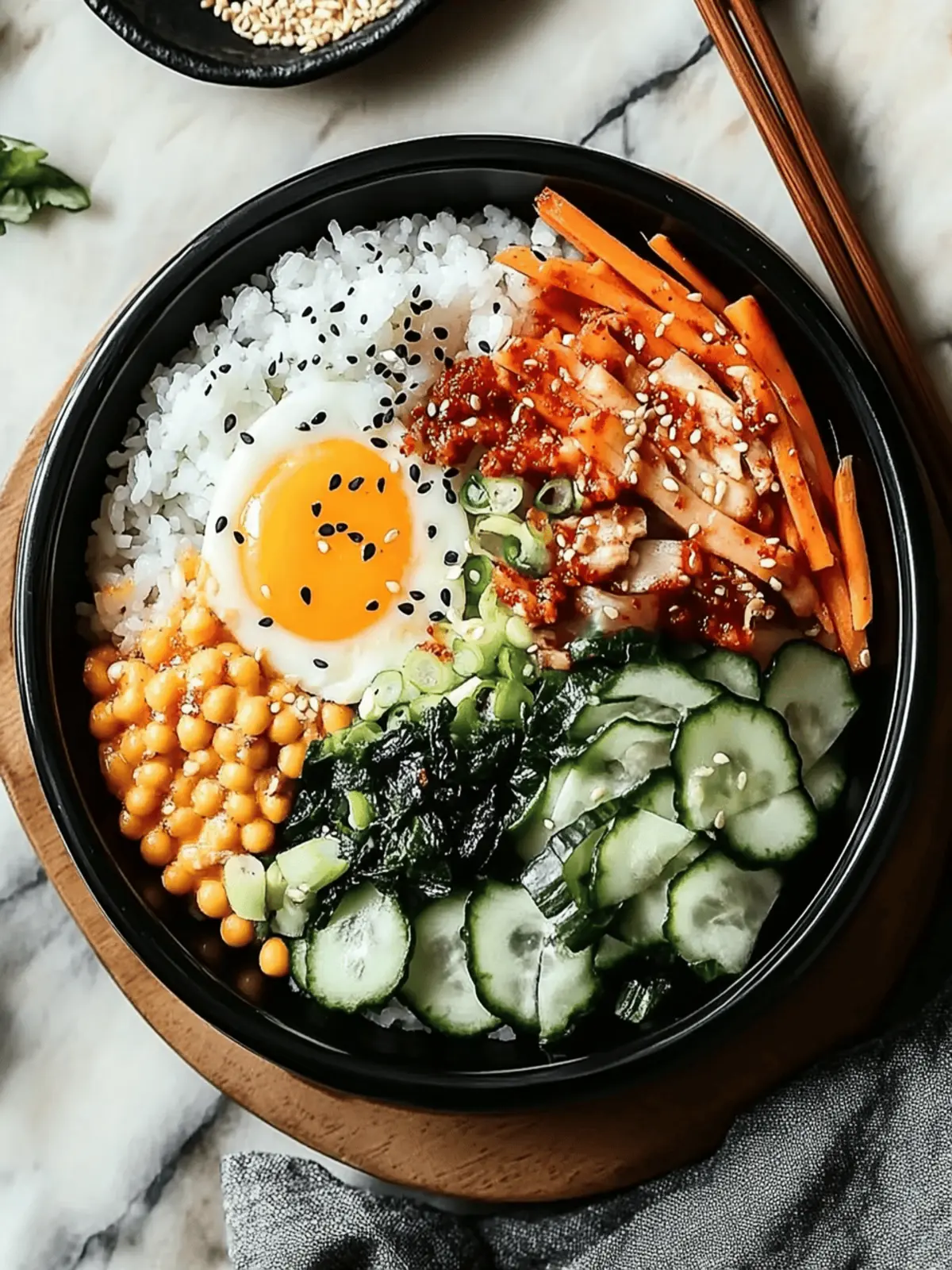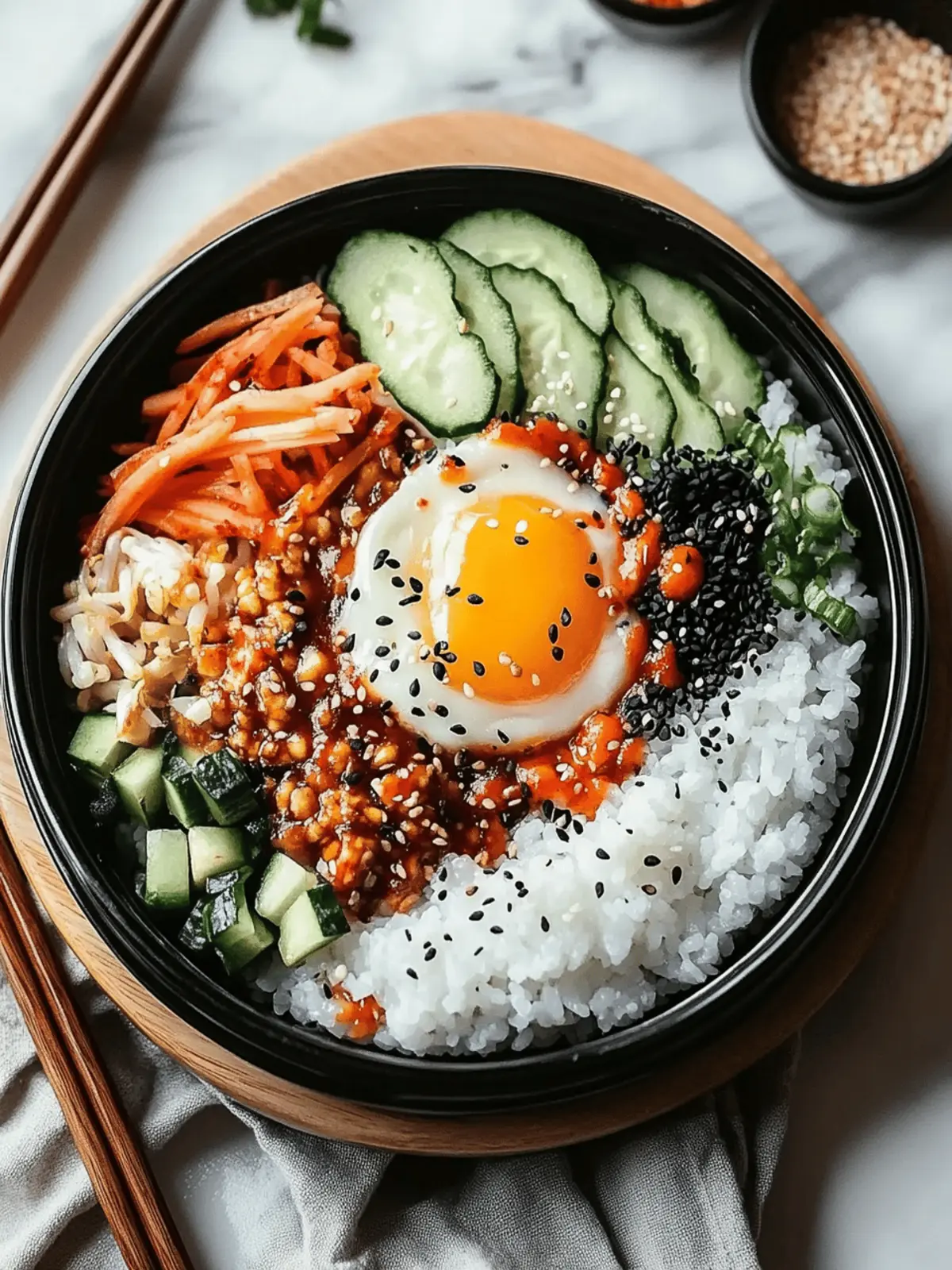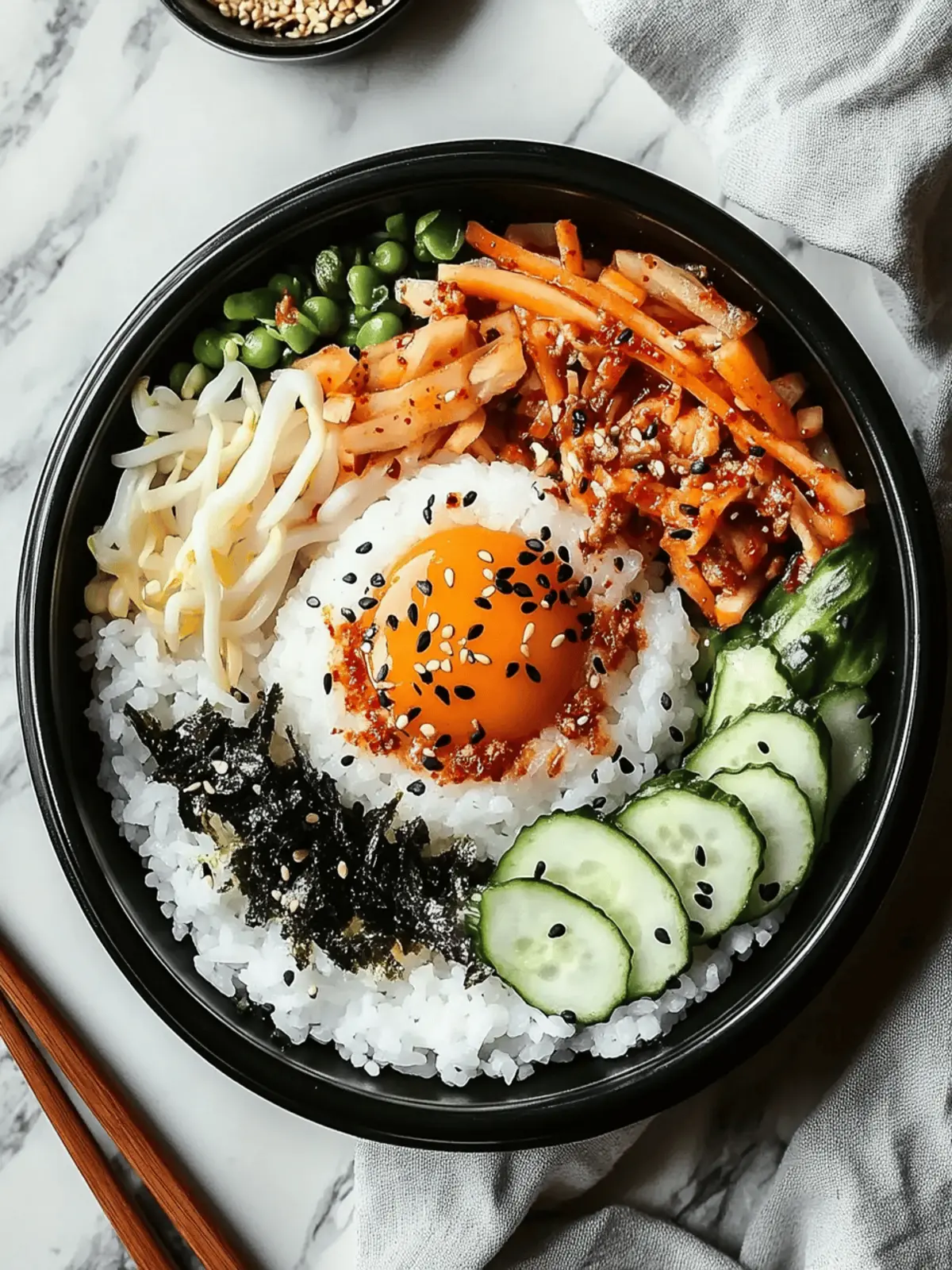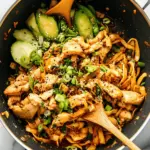As the vibrant colors of summer fade and autumn’s embrace begins, there’s a comfort I crave that reminds me of home—Korean Bibimbap. Picture this: warm, slightly crispy rice forming the perfect base, dressed with an array of sautéed vegetables, savory beef or tofu, and crowned with a decadent sunny-side-up egg. And let’s not forget the final touch—a drizzle of spicy gochujang sauce that ties it all together.
This dish is not only a feast for the eyes; it’s a delightful medley of textures and flavors that transform a simple mealtime into a colorful celebration. Whether you’re seeking a healthy weeknight dinner, a vegetarian option that’s anything but boring, or a gluten-free delight that packs a punch, Bibimbap has you covered. Besides, it’s a wonderful way to clean out your fridge—just throw in whatever vegetables you have on hand! Get ready to dive into the realm of deliciousness as we craft this comforting, satisfying bowl that promises to excite your palate and warm your heart.
Why is Korean Bibimbap a must-try?
Colorful, vibrant ingredients make Korean Bibimbap a feast for the eyes! Healthy and versatile, it welcomes any veggies, allowing you to clean out your fridge. Quick to prepare, this dish transforms a simple meal into a celebratory experience in under 30 minutes. Satisfying textures combine crispy rice, tender veggies, and creamy yolk, promising each bite is a delight. Plus, it’s a fantastic choice for everyone—whether you opt for savory beef, tofu, or a vegetarian version, your taste buds will thank you!
Korean Bibimbap Ingredients
Get ready to create a deliciously colorful dish with these fresh ingredients!
For the Rice
• Cooked Rice – The heart of your bibimbap; short or medium grain enhances stickiness.
• Sesame Oil – Adds rich, nutty flavor to your rice base.
For the Vegetables
• Spinach – A nutritious and vibrant addition; kale can substitute if you like.
• Bean Sprouts – Offers a delightful crunch; consider snow peas if you need an alternative.
• Shiitake Mushrooms – Provides earthiness; other types like cremini work, too.
• Carrots – Add color and texture; radishes offer a spicy twist if desired.
• Cucumber – A refreshing contrast; zucchini makes a lighter swap.
For the Protein
• Large Eggs – Fried sunny-side up for creaminess; scrambled tofu is a perfect vegan option.
For the Sauce
• Gochujang (Korean Chili Paste) – The key ingredient for a kick of spice and flavor; substitute with a mix of sriracha and sugar if needed.
• Soy Sauce – Balances the dish with umami depth.
• Garlic – Freshly minced for aromatic goodness.
• Sugar – To mellow out the sauce; a little goes a long way.
• Rice Vinegar – Adds a touch of acidity for balance.
• Olive Oil – Used for sautéeing, offering a mild flavor.
For the Garnish
• Sesame Seeds – Adds a nutty finish; chopped nuts can also provide extra crunch.
Korean Bibimbap is not just a dish; it’s a canvas for flavors waiting to be explored. Enjoy your cooking adventure!
How to Make Korean Bibimbap
-
Heat Oil: In a medium pan, warm sesame oil over medium heat, then add cooked rice. Stir-fry for 2-3 minutes until the rice is slightly crispy and golden. Set it aside on a serving plate.
-
Sauté Mushrooms: In the same pan, pour in vegetable oil. Add sliced shiitake mushrooms and cook for about 4-5 minutes until they soften. Stir in minced garlic and let it cook for an additional minute for added flavor.
-
Cook Eggs: In a separate pan, fry the large eggs sunny-side up until they reach your desired doneness—crispy edges and a runny yolk are perfect for this dish!
-
Blanch Vegetables: In boiling water, blanch spinach and bean sprouts for about 1 minute, then drain and set aside. This process will keep them bright and vibrant.
-
Prepare Veggies: Julienne carrots and cucumber into thin strips. This adds a delightful crunch to your bowl while making it visually stunning.
-
Mix Sauce: In a small bowl, combine gochujang, soy sauce, rice vinegar, sesame seeds, sugar, and olive oil. Stir until well mixed to create the perfect flavorful sauce to drizzle later.
-
Assemble the Dish: In a large bowl, layer the stir-fried rice. Neatly arrange the sautéed mushrooms, blanched vegetables, julienned carrots, and cucumber on top. Finally, crown it with a fried egg and drizzle generously with the gochujang sauce before serving.
Optional: Garnish with extra sesame seeds or chopped nuts for added crunch.
Exact quantities are listed in the recipe card below.
Korean Bibimbap Variations
Feel free to get creative and put your spin on this delicious dish with these swapping suggestions!
-
Vegetarian: Replace beef with tofu or tempeh for a delightful meat-free option. It absorbs flavors beautifully and becomes wonderfully satisfying.
-
Gluten-Free: Use tamari instead of soy sauce to keep this dish gluten-free without sacrificing any of its savory goodness.
-
Spicy Kick: Increase the heat by adding sliced jalapeños or a few dashes of chili oil atop your finished bibimbap. It’s a spicy twist that can wake up your taste buds!
-
Colorful Veggie Medley: Swap out traditional veggies for seasonal favorites like bell peppers, sweet potatoes, or even roasted corn. The more colors, the more fun—and flavor!
-
Egg Replacement: For a vegan dish, substitute the fried egg with a scooped mound of avocado or a sprinkle of nutritional yeast for that creamy texture and extra nutrient boost.
-
Roasted Flavor: Experiment with roasted vegetables instead of sautéed ones. Roasting brings out natural sweetness and deep flavor; think of carrots, butternut squash, or brussels sprouts.
-
Rice Alternatives: Try cauliflower rice for a low-carb version! With all the flavors surrounding it, you might not even notice the difference.
-
Saucy Enhancements: Mix gochujang with peanut butter or tahini for a nutty flair. This rich twist adds an unexpected layer of deliciousness that’ll keep you coming back for seconds!
Expert Tips for Korean Bibimbap
-
Rice Quality: Use slightly cooled or day-old rice for the best stir-fry texture; fresh rice can turn mushy when cooked.
-
Flavor Balance: Adjust the gochujang according to your spice preference; start with less and add more for heat without overwhelming the dish.
-
Veggie Prep: Cut vegetables into uniform sizes for even cooking; this ensures that each bite has a perfect balance of flavors and textures.
-
Mixing: Don’t skip the mixing step before eating! Thoroughly combine the rice, veggies, and sauce to enhance the overall flavor experience in your Korean Bibimbap.
-
Storage Tips: Store cooked ingredients separately to prevent sogginess; reheating rice with a splash of water helps restore its original texture.
Storage Tips for Korean Bibimbap
-
Room Temperature: Best enjoyed fresh, but if needed, leftovers can sit out for up to 2 hours before refrigerating for food safety.
-
Fridge: Store any leftover Korean Bibimbap in an airtight container for up to 3 days. Keep rice and vegetables separate to maintain texture and flavor.
-
Freezer: Freeze the rice and any cooked veggies in separate airtight containers for up to 2 months. This is a great way to enjoy your Korean Bibimbap later!
-
Reheating: Reheat rice in the microwave with a splash of water to restore its moisture. Sauté vegetables on the stovetop for a quick refresh before serving.
Make Ahead Options
Korean Bibimbap is a fantastic recipe to make ahead, perfect for those busy weeknights! You can prepare the vegetables—such as sautéed shiitake mushrooms, blanched spinach, and bean sprouts—up to 3 days in advance. Simply store them in airtight containers in the refrigerator to keep them fresh and vibrant. The cooked rice can also be made ahead and refrigerated for up to 24 hours; reheat it with a splash of water to restore its texture. When you’re ready to serve, quickly fry your egg and assemble the bowl with the prepared components, drizzle with gochujang sauce, and enjoy a delicious meal that feels just as fresh as on the day it was made!
What to Serve with Korean Bibimbap?
Elevate your dining experience with delicious companions that enhance the vibrant flavors of this classic dish.
-
Kimchi: A traditional side that adds a spicy crunch, kimchi brings an extra layer of flavor and probiotic goodness to your meal.
-
Sesame Spinach Salad: The nutty and refreshing taste of sesame complements the bibimbap, while adding an extra veggie boost that’s always welcome.
-
Korean Fried Chicken: Crispy, succulent fried chicken pairs beautifully with the rice bowl, offering a satisfying crunch that harmonizes with the dish’s textures.
-
Cucumber Salad: A light and tangy cucumber salad balances the richness of the bibimbap with its refreshing profile—a perfect palate cleanser!
-
Iced Green Tea: Serve with a chilled glass of iced green tea, which provides a crisp and herbal note, enhancing the meal’s overall freshness.
-
Mango Sticky Rice: For dessert, indulge in sweet mango sticky rice. Its creamy texture and sweetness beautifully contrast the savory elements of bibimbap.
These pairings will ensure your Korean Bibimbap dining experience is not just a meal, but a delightful culinary journey!
Korean Bibimbap Recipe FAQs
How do I choose the right vegetables for Korean Bibimbap?
Absolutely! Use a mix of colorful, fresh vegetables like spinach, carrots, cucumbers, and mushrooms. They not only enhance the visual appeal but also provide a variety of textures and nutrients. Feel free to swap in seasonal veggies or whatever you have in your fridge, like zucchini or bell peppers!
What’s the best way to store leftover Korean Bibimbap?
Very simple! Refrigerate any leftovers in airtight containers. To keep everything fresh, store rice separately from the cooked vegetables for up to 3 days. This prevents the rice from becoming soggy and helps maintain the crunchiness of your veggies.
Can I freeze Korean Bibimbap, and if so, how?
Absolutely! Freeze the cooked rice and vegetables in separate airtight containers for up to 2 months. First, let everything cool to room temperature. Then, portion into containers or bags, and press out as much air as possible before sealing. When you’re ready to enjoy, thaw in the fridge overnight and reheat with a splash of water for the rice.
What should I do if my rice gets too soggy when cooking?
No worries! If you find your rice too soggy, it usually means it was too fresh when stir-frying. Next time, use day-old rice for the best texture. If you’re in a pinch, spread the soggy rice on a baking sheet to cool and dry out before using it in your Bibimbap.
Can I make Korean Bibimbap gluten-free?
Definitely! To make a gluten-free version, just use tamari instead of soy sauce, and check that your gochujang paste is gluten-free as well. This delicious dish can be easily adapted for various dietary needs, ensuring everyone can enjoy a vibrant bowl of Bibimbap!
Is Korean Bibimbap suitable for pets or have any allergies?
While ingredients like veggies and rice are safe for pets, avoid feeding them gochujang since it can be spicy. Always check for personal allergies. If you or your family members have specific dietary restrictions, feel free to modify the ingredients, which makes Bibimbap such a customizable option.
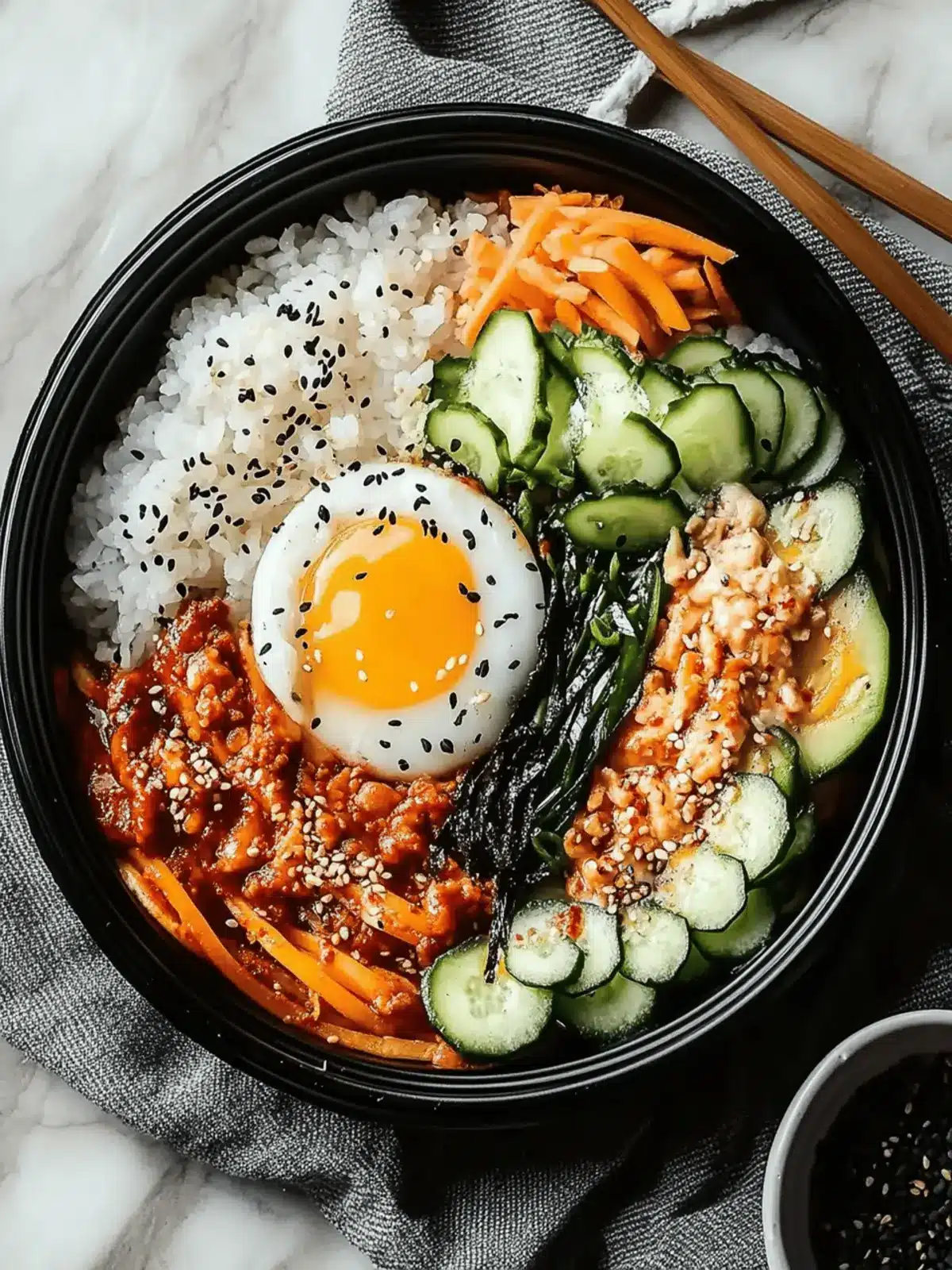
Korean Bibimbap: Vibrant Rice Bowl for Any Home Cook
Ingredients
Equipment
Method
- Heat sesame oil in a medium pan over medium heat, add cooked rice, and stir-fry for 2-3 minutes until slightly crispy. Set aside.
- In the same pan, add vegetable oil, sauté shiitake mushrooms for 4-5 minutes, then stir in minced garlic and cook for an additional minute.
- In a separate pan, fry the large eggs sunny-side up to desired doneness.
- Blanch spinach and bean sprouts in boiling water for 1 minute, drain and set aside.
- Julienne carrots and cucumber into thin strips.
- In a small bowl, mix gochujang, soy sauce, rice vinegar, sesame seeds, sugar, and olive oil until well combined.
- In a large bowl, layer stir-fried rice and top with sautéed mushrooms, blanched vegetables, julienned carrots, cucumber, and fried egg. Drizzle with the sauce before serving.

